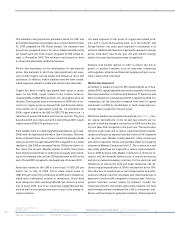Siemens 2009 Annual Report Download - page 150
Download and view the complete annual report
Please find page 150 of the 2009 Siemens annual report below. You can navigate through the pages in the report by either clicking on the pages listed below, or by using the keyword search tool below to find specific information within the annual report.
62
Reports Supervisory Board /
Managing Board Corporate Governance Management’s discussion and analysis Consolidated Financial Statements
44 Business and operating environment 63 Fiscal 2009 – Financial summary 66 Results of operations 84 Financial position
The estimates and projections presented above for GDP and
gross fixed investments are based upon a report dated October
14, 2009 prepared by IHS Global Insight, the estimates and
projections presented above for value added manufacturing
are based upon the recent report prepared by IHS Global In-
sight in November 2009. The estimates and projection have
not been independently verified by Siemens.
We are also dependent on the development of raw material
prices. Key materials to which we have significant cost expo-
sure include copper, various grades and formats of steel, and
aluminum. In addition, within stainless steel we have consid-
erable exposure related to nickel and chrome alloy materials.
Copper has been a highly speculative base metal in recent
years. In July 2008, copper traded on the London metal ex-
change (LME) at US$8,985 per metric ton, the highest price for
the year. The financial crisis in the autumn of 2008 led to a cor-
rection in copper prices as demand fell and financial institu-
tions pulled out of speculative positions. On December 24,
2008, copper traded on the LME at US$2,770 per metric ton – a
reduction of nearly 70% within less than six months. The price
has rebounded since then, and at the end of fiscal 2009 copper
traded around US$6,100 per metric ton.
Steel markets were in a tight supply/demand balance up to mid-
2008, with the highest price levels in July of that year. The melt-
down of demand from the economic downturn brought global
steel prices down by approximately 55% compared to the levels
reached in July 2008 as measured by the CRUspi steel price in-
dex. Since the second calendar quarter of 2009, steel prices
have slowly recovered due to reductions in supply and restock-
ing on the demand side, and the CRUspi had risen by 23% at the
end of fiscal 2009 compared to the beginning of January 2009.
Aluminum traded on the LME at a year high of US$3,292 per
metric ton in July of 2008. Prices came slowly down to
US$1,253 per metric ton in February of 2009 due to weaker de-
mand and a substantial increase in inventories. Prices have
been rising since then, reaching US$1,852 per metric ton at the
end of fiscal 2009, due to an improving supply/demand bal-
ance as well as increasing production costs for the energy-in-
tensive material.
Our main exposure to the prices of copper and related prod-
ucts, and to steel and stainless steel, is in the Industry and
Energy Sectors. Our main price exposure to aluminum is in
Industry. Additionally Siemens is generally exposed to energy
prices, both direct (electricity, gas, oil) and indirect (energy
used in the manufacturing processes of suppliers).
Siemens uses several options in order to reduce the risk in
project or product business, such as long-term contracting
with suppliers, physical and financial hedging and price esca-
lation clauses with customers.
Market development
According to market surveys by IHS Global Insight as of Sep-
tember 2009, capital expenditures within nearly all of the main
branches served by our Sectors and Siemens IT Solutions and
Services declined in calendar year 2009 compared to 2008. For
comparison, all the branches increased their level of capital
investment in 2008 by double-digit or high single-digit per-
centage rates compared to the prior year.
Within the markets served predominantly by our Industry Sec-
tor, capital expenditures in the oil and gas industry are ex-
pected to show the sharpest contraction in 2009 with a decline
of more than 20% compared to the prior year. The automotive
industry is also expected to reduce capital investment signifi-
cantly, resulting in an expected decline of about 16% compared
to the prior year. Weaker overall demand, rising inventories
and excess capacities will be only partially offset by scrapping
schemes in Western Europe and the U.S. The construction and
real estate industries are expected to reduce capital expendi-
ture in 2009 by about 14%. Market contraction is driven by re-
cession and the financial market crisis in mature economies
and also in several emerging countries. For the electrical and
electronics as well as the pulp and paper industries, the de-
cline in capital expenditures in 2009 is estimated at about 10%.
The reduction in investments in the transportation and infra-
structure industry and the wholesale and retail businesses is
expected to be about 8% compared to the prior year. Other im-
portant branches served mainly by Industry include the
chemicals industry, the metals and mining markets, the food
and beverage industry weakened by a fall in consumer confi-
dence, and the transport equipment industry. All are expected
























